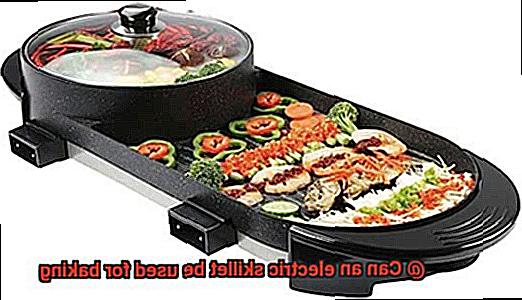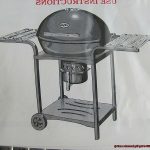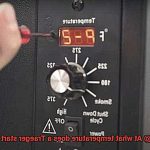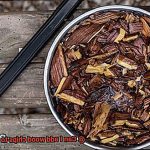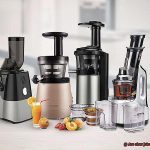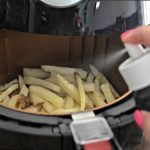Are you tired of firing up your oven every time you want to bake something? Do you wish there was a more efficient way to whip up some quick treats without wasting energy? Well, what if we told you that your trusty electric skillet could be the answer to all your baking woes?
Yes, you heard that right. Your favorite kitchen gadget isn’t just for frying bacon and eggs. It can also be used for baking. But we know what you’re thinking – can an electric skillet really handle the delicate art of baking? Don’t worry; we’ve got your back. With a few tips and tricks, you’ll be able to use your electric skillet for all sorts of baked goodies.
In this blog post, we’ll cover everything from the benefits of using an electric skillet for baking to which recipes work best. We’ll even throw in some expert advice on how to ensure your baked goods come out perfect every single time. So, put on your apron and get ready to explore a whole new world of baking possibilities with your electric skillet.
Contents
What is an Electric Skillet?
It’s a versatile kitchen appliance that can help you cook a wide variety of dishes with ease. Its portable, plug-in design allows it to heat up quickly and maintain a consistent temperature, making it perfect for frying, sautéing, braising, and even baking.
Electric skillets come in different shapes and sizes to suit your needs. Whether you’re cooking for yourself or a large family, there’s an electric skillet that’s right for you. Some models feature heat-resistant handles for added safety, while others have detachable bases for easy use and cleaning.
One of the most significant advantages of an electric skillet is its non-stick surface. Food won’t stick to the pan, making it a breeze to clean up after cooking. Its high sides make it perfect for cooking stews and casseroles too. The lid helps keep food moist and tender, ensuring perfect results every time.
But did you know that electric skillets can be used for baking as well? While they may not be as precise as traditional ovens, with some modifications and adjustments, you can bake certain types of food in them. Casseroles, quiches, and even pizza can be baked with great results. Just remember to monitor your food closely and make adjustments as needed to ensure that it cooks evenly.
Can an Electric Skillet Be Used for Baking?
First and foremost, it’s important to understand that while an electric skillet can be used for certain baked goods like cakes, bread, and pizza, it’s not a true substitute for an oven. Its size and shape will limit the size and shape of your creations. So don’t expect to bake a large turkey or a multi-layer cake in your electric skillet.
When using an electric skillet for baking, temperature control is key. Electric skillets often have a range of temperature settings, but they may not always be accurate. To ensure that your baked goods are cooked to perfection, it’s recommended to use an oven thermometer to monitor the temperature inside the skillet.
Another important factor is using the right bakeware for the job. Different dishes may require specific types of pans, such as a loaf pan or a round cake pan. Make sure to use the appropriate bakeware for the dish you’re baking in order to achieve the desired results.
Lids aren’t just for pots and pans anymore. One technique that can be helpful when using an electric skillet for baking is using a lid. The lid will help trap in moisture and create a more even cooking environment, which can be especially helpful when baking bread.
But before you start whipping up your favorite baked goods in your electric skillet, keep in mind that there are limitations. The size and shape of your skillet will dictate what you can bake, and you’ll need to be mindful of temperature control and proper bakeware.
Benefits of Using an Electric Skillet for Baking
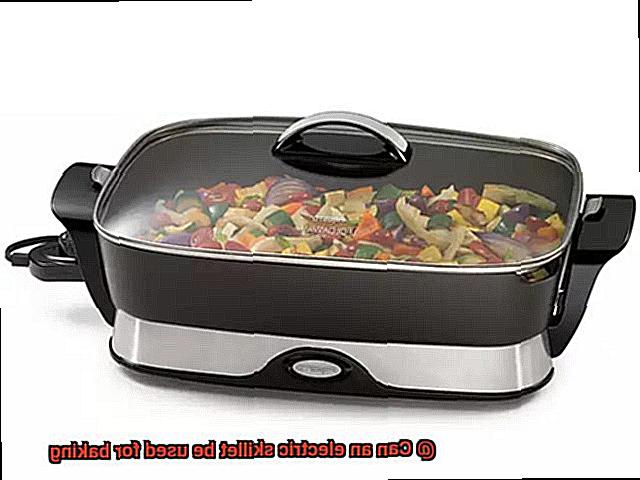
Look no further than an electric skillet. As an expert in the benefits of using an electric skillet for baking, I am here to tell you all about the convenience, versatility, and energy efficiency this appliance can offer.
Firstly, let’s talk about convenience. Electric skillets are compact and easy to store, making them perfect for small apartments or limited counter space. And with their portability, you can take them on outdoor adventures or camping trips for delicious baked treats on-the-go.
But it’s not just about convenience. Electric skillets offer versatility that traditional ovens simply can’t match. From cakes to pies, bread to pizza, and even roasts and casseroles – an electric skillet can do it all. The possibilities for new recipes are endless with this handy appliance.
And don’t forget about energy efficiency. Electric skillets heat up quickly and maintain a consistent temperature, which means less time and energy needed to cook your food compared to traditional ovens. You can save money on your energy bills without sacrificing the quality of your baked goods.
Tips for Successfully Baking with an Electric Skillet
Electric skillets are an excellent way to bake your favorite dishes without having to use a conventional oven. However, there are some tips and tricks that you need to keep in mind to ensure that your baked goods come out perfectly. Here are some tips for successfully baking with an electric skillet:
Choose the Right Pan:
The first thing to consider when baking with an electric skillet is the type of pan you use. A non-stick skillet with high sides is perfect for baking cakes and bread, as it allows for even heat distribution and prevents sticking. Additionally, make sure to preheat the skillet before adding any batter to achieve the best results.
Temperature Control is Crucial:
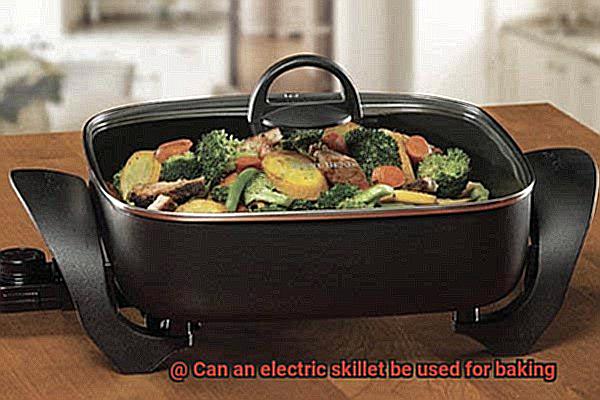
It’s essential to have proper temperature control when using an electric skillet for baking. Set the temperature between 325-350°F, as temperatures higher than this can lead to uneven baking or burnt edges. Keep an eye on the skillet and adjust the temperature as needed throughout the baking process.
Cover the Skillet:
Covering the skillet with a lid or aluminum foil is another essential tip to ensure even cooking while preventing the top of baked goods from drying out. This is especially important for bread, which requires a moist environment to rise correctly.
Be Patient:
Baking in an electric skillet may take longer than traditional oven baking, but with proper temperature control and attention to detail, delicious baked goods can be achieved. So don’t rush it; be patient and let your dish bake at its own pace.
Cool Before Removing:
Lastly, it’s crucial to let your baked goods cool entirely before removing them from the electric skillet. This can help prevent sticking or breaking apart. Using a non-stick cooking spray or parchment paper can also help prevent sticking.
Types of Dishes That Can Be Baked in an Electric Skillet
An electric skillet may not seem like an obvious choice for baking, but it can actually be a versatile tool in the kitchen. Here are five types of dishes that can be baked in an electric skillet:
Cornbread
Baking cornbread in an electric skillet allows for an even cooking surface, resulting in a crispy crust and fluffy interior. The skillet’s high sides also prevent any spills or messes.
Casseroles
These hearty dishes are easy to customize with a variety of ingredients, and the skillet can go from stovetop to oven, making it perfect for dishes that require both cooking methods. Popular options include macaroni and cheese, lasagna, and shepherd’s pie.
Pizza
The even heating surface of the skillet ensures that the crust cooks evenly and the toppings melt perfectly. Plus, the high sides prevent any toppings from spilling over.
Cakes, brownies, and cheesecake
Sweet treats are also possible to make in an electric skillet with a bit of extra attention to ensure they don’t burn or overcook. Non-stick spray or parchment paper can help prevent sticking to the bottom of the skillet.
Bread
From simple loaves to artisan breads, baking bread in an electric skillet requires proper proofing of the dough before placing it in the skillet. This allows for proper rising and prevents the bread from becoming too dense.
Temperature Control When Baking in an Electric Skillet
First things first, preheating your electric skillet to the desired temperature is key to ensuring that your dish cooks evenly and thoroughly. But it doesn’t stop there. It’s equally important to keep a close eye on the temperature of the skillet throughout the baking process to maintain a consistent heat level.
However, not all electric skillets are created equal. Investing in a high-quality electric skillet with reliable temperature control features will make all the difference in your baking experience.
One of the most common mistakes made when using an electric skillet for baking is setting the temperature too high or too low. Overheating can result in burnt or unevenly cooked dishes, while underheating can lead to undercooked food. Starting with a lower temperature and gradually increasing it as needed is recommended for optimal results.
Taking it up a notch, using an oven thermometer to check the accuracy of the skillet’s temperature control system is a pro tip that can save you from potential disasters. This step will help you determine if adjustments need to be made to achieve your desired temperature.
Common Mistakes to Avoid When Baking in an Electric Skillet
Before you get started, it’s essential to avoid the common mistakes that can ruin your baked goods. As an expert in baking with electric skillets, I’ve got the inside scoop on what to watch out for.
First and foremost, don’t forget to preheat your skillet. Skipping this step is a recipe for disaster. Your food will end up unevenly baked or burnt. To prevent this from happening, take the time to preheat your skillet to the desired temperature before adding your batter or dough. Trust me; it’s worth the wait.
Another mistake to avoid is using the wrong type of skillet. Not all electric skillets are created equal, and some may not be suitable for baking due to their size or shape. Before attempting to bake in your electric skillet, check the manufacturer’s instructions.
When it comes to overcrowding your skillet, less is definitely more. Overcrowding with too much batter or dough can lead to uneven baking, so leave enough space around each item to ensure even cooking. Remember that patience is key. It’s better to bake in batches than to rush the process and compromise the quality of your baked goods.
Choosing the right baking dish is also crucial for successful baking in an electric skillet. Make sure to select a dish that is suitable for your skillet and the type of food you are baking. A dish that fits snugly in your skillet will help distribute heat evenly and ensure that your baked goods are cooked to perfection.
Finally, resist the urge to open the lid too often. Doing so can cause fluctuations in temperature, which can affect the outcome of your baked goods. Only open the lid when necessary and keep a watchful eye on your food through the clear glass lid of your electric skillet.
Alternatives to Using an Electric Skillet for Baking
While an electric skillet may seem like a convenient option for baking, it may not always provide the best results. Thankfully, there are several alternatives that can be used to achieve similar outcomes and take your baked goods to the next level.
First on our list is the classic traditional oven. This appliance offers complete control over temperature and cooking time, making it perfect for delicate baked goods such as cakes and pastries. Plus, its even heat distribution ensures that your treats come out perfectly every time. With its versatility and precision, it’s no wonder that this is a go-to option for bakers all around the world.
Another great alternative is the toaster oven. Don’t let its size fool you – toaster ovens are powerful and efficient when it comes to baking. They offer even heat distribution and come with a variety of settings that can be used to bake small batches of food. Toasters also offer versatility in cooking with options such as convection and broil, allowing you to get creative with your recipes.
If you’re feeling adventurous, try using a Dutch oven for your baking needs. Though primarily used for stovetop cooking, a Dutch oven can also be utilized in the oven to bake bread and other baked goods. Its thick walls provide even heat distribution, while its lid helps to trap moisture resulting in a crispy crust. This versatile piece of cookware is perfect for anyone who wants to experiment with different baking techniques.
Lastly, don’t overlook the humble slow cooker. While not typically considered for baking, slow cookers are perfect for certain types of desserts such as cakes and cobblers. Though the texture may differ slightly from traditional baking methods, slow cookers are great for creating moist and flavorful treats with minimal effort. Plus, they’re perfect for busy bakers who want to set it and forget it.
t55suA67CEo” >
Conclusion
In conclusion, the electric skillet can be a game-changer in your baking routine. Its non-stick surface and high sides make it perfect for casseroles, cornbread, pizza, cakes, and brownies. But before you get started with your baking adventure on an electric skillet, there are some important considerations to keep in mind.
Temperature control is crucial when using an electric skillet for baking. Ensure that you have the right bakeware and monitor your dish closely throughout the baking process. With patience and attention to detail, delicious baked goods can be achieved in your trusty electric skillet.
The benefits of using an electric skillet for baking are numerous – from convenience and versatility to energy efficiency. If you’re not sold on using an electric skillet yet, traditional ovens, toaster ovens, Dutch ovens, and slow cookers all offer their own unique advantages.
So unleash your creativity and experiment with new recipes on your electric skillet.

